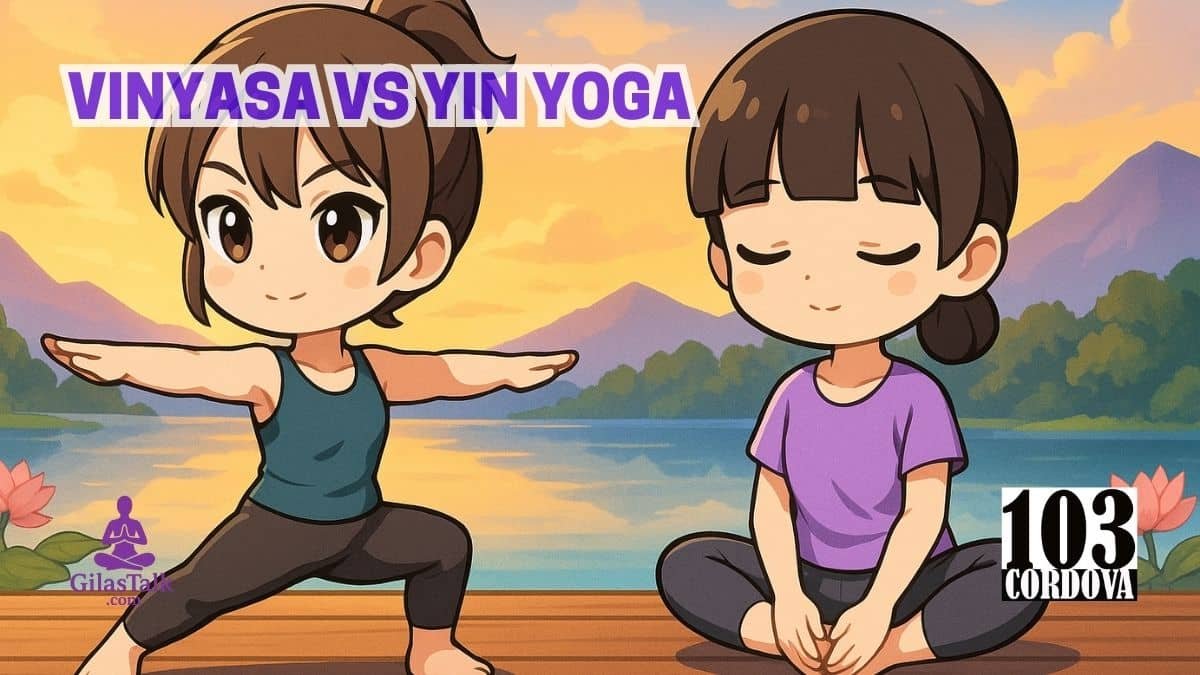When comparing Vinyasa Vs Yin Yoga, it is important to know that these are two very different approaches.
Vinyasa focuses on active movements that flow from one pose to another.
Yin Yoga focuses on holding poses for long periods to stretch deeper tissues.
Both are helpful for fitness, but they meet different needs.
We’ll explain their differences so you can choose the one that matches your goals.
1. Overview Of Vinyasa And Yin Yoga
Vinyasa is a dynamic style of yoga where poses flow smoothly from one to the next, often guided by breathing patterns.
This creates steady movement that feels like exercise while still focusing on flexibility and balance.
Because of its pace, many people see Vinyasa as an energizing practice that builds strength over time.
A yin yoga class works differently by asking students to hold poses for several minutes with the muscles relaxed.
This approach helps release tension and gently works on joints, ligaments, and connective tissue.
The slower style allows for deeper stretches that improve flexibility and calm the mind.
Understanding how each style of yoga functions gives you a clearer idea of what to expect and which may suit your goals.
🧘 Hot Yoga Vs Regular Yoga: Which One is Right for You?
2. Physical Intensity Comparison
Vinyasa raises the heart rate because it moves quickly and uses strength-based poses that keep the body active.
The flow can feel vigorous, especially when many poses are linked together without much rest.
It also challenges endurance, balance, and coordination, making it a strong choice for people who want a workout-like experience.
Power yoga, which is often grouped with Vinyasa, takes intensity even higher by adding longer sequences and faster transitions.
Yin, by contrast, is much calmer since it focuses on long-held positions that allow the body to stretch without heavy effort.
The slower pace makes Yin feel meditative, helping the mind stay calm while the body gently opens.
Knowing how different the effort feels between these two styles makes it easier to choose one that matches your energy and goals.
🧘 Ashtanga Yoga Vs. Vinyasa Yoga: Key Differences and Benefits Explained
3. Common Fitness Goals
Many people practice yoga to improve strength, mobility, or stress relief, and each style offers something different.
Some people look for a workout that burns calories and feels physically demanding, while others prefer slower routines that help release tension.
Vinyasa is often chosen for building stamina and endurance because of its steady movement and active flow.
Yin is better for people who want to relax, recover, and stretch deeply without pushing the body too hard.
Other practices, such as hatha yoga, can provide a balanced middle ground between physical effort and steady breathing.
Restorative classes are also popular for those who need gentle support after long days or during recovery from stress.
Thinking about your main purpose before starting helps you stay motivated and find the practice that matches your needs.
🧘 Why Chair Yoga Training Is Essential for Office Workers
4. Yoga Styles Matched To Goals
Vinyasa is a good choice for people who want an active practice that builds muscle strength and stamina through steady movement.
It also benefits those who enjoy connecting each pose with the rhythm of their breath, which creates flow and focus.
Yin works well for people who need deeper stretches that target flexibility and joint health through long holds.
This style also supports rest and mental calm, making it a useful option after a demanding day.
Restorative yoga is another gentle style that helps reduce stress and supports recovery, especially for people who need more relaxation than physical effort.
Kundalini yoga can be chosen by those who want a practice that includes breathing, chanting, and movement for both physical and spiritual growth.
Matching your goals with the right style ensures that your practice feels rewarding and supports your personal needs.
🧘 Why Somatic Yoga Training is a Game Changer for Stress Relief
5. Mental And Emotional Benefits
Vinyasa can improve focus because it requires attention to posture and timing.
The steady rhythm of breath with motion can calm nervous energy.
Yin, on the other hand, creates stillness that encourages reflection and patience.
Spending several minutes in one pose can also ease tension in the mind.
Both forms help mental health, but in very different ways.
🧘 Can Heated Vinyasa Yoga Help You Lose Weight Effectively?
6. Session Length And Pacing
A typical Vinyasa class lasts 45 to 60 minutes and rarely stops moving.
Each pose connects to the next, which keeps the energy level high.
Yin classes often last a similar amount of time but feel slower.
Poses are held anywhere from three to five minutes, creating a very different experience.
The way time is used makes each style feel unique, even if the session length is the same.
🧘 How to Learn Aerial Yoga Poses Names for a Better Practice
7. Injury Recovery And Prevention
Vinyasa may be difficult for people recovering from joint or muscle problems.
The repeated movements can place stress on sensitive areas.
Yin uses gentle positions that are easier on the body, which may help with recovery.
It also supports long-term joint health by stretching connective tissues.
Choosing the safer option for your condition can prevent setbacks and improve healing.
🧘 Exploring the Benefits of Meditation and Yoga
8. Suitable Skill Levels
Vinyasa is often better for people with some background in yoga or exercise.
The quick transitions and balance work can be hard for beginners.
Yin is accessible to most people because it focuses on comfort and stillness.
Props like blocks and blankets can also make Yin easier for all skill levels.
Thinking about your current ability can help you decide where to start.
🧘 Surprising Benefits of Yoga for Health You Need to Know
9. Combining Vinyasa And Yin
Many people use both styles at different times of the week.
Vinyasa can build strength and energy, while Yin can restore flexibility and calm.
Using both allows a balance between effort and rest.
This approach also reduces the risk of burnout or boredom.
Mixing the styles can give you a well-rounded yoga practice.
🧘 How the Benefits of Daily Yoga Can Transform Your Life
10. Tips For Trying Both Styles
If you are unsure which to choose, start with short beginner classes.
Pay attention to how your body feels during and after each style.
Try both for a few weeks to see which aligns with your fitness goals.
You may decide to focus on one or keep both in your routine.
Listening to your body will guide your best choice.
💡 Conclusion
Vinyasa Vs Yin Yoga is not about finding which one is better overall.
It is about choosing the practice that supports your personal fitness needs.
Vinyasa works well for energy and strength, while Yin helps with recovery and calm.
Both offer unique benefits that can improve health in different ways.
By knowing these differences, you can build a yoga practice that fits your goals.
🤝 Our Friends’ Services
At 103 Cordova Activity Space, we offer yoga classes for all ages in a friendly and welcoming environment.
Our classes are designed to help improve strength, flexibility, and relaxation, whether you are a beginner or experienced.
We are located at 103 Cordova Tower, Marquinton Residences, Cirma Street, Sto. Niño, Marikina City, for easy access.
You can reach us at 0917-622-5780, through Facebook, or by using the contact form on our site.
Join us today and experience the benefits of yoga for your body and mind.
❓ FAQs
1. Can beginners try both Vinyasa and Yin Yoga?
Yes, beginners can try both, but Vinyasa may feel more challenging at first.
Yin is often easier to start with because it focuses on slower movements and longer holds.
Using props in Yin can make it even more beginner-friendly.
2. How many times a week should I practice Vinyasa Vs Yin Yoga?
If your goal is strength and stamina, you might practice Vinyasa three to four times a week.
Yin can be done two to three times a week to support recovery and flexibility.
Some people combine both by alternating styles throughout the week.
3. Is Vinyasa better for weight loss than Yin Yoga?
Vinyasa can support weight loss because of its higher intensity and continuous movement.
Yin does not burn as many calories but helps reduce stress, which can also support healthy habits.
Both can contribute to overall fitness when combined with a balanced lifestyle.
4. Can Yin Yoga help with back pain or tight muscles?
Yes, Yin can help release tension in the back and stretch tight muscles over time.
The long holds target deep tissues, which can improve flexibility and joint health.
However, it is best to consult a professional if you have serious pain or injuries.
5. Do I need special equipment for Vinyasa Vs Yin Yoga?
For Vinyasa, a yoga mat is usually enough, though blocks and straps can help with balance.
Yin often uses props like blankets, bolsters, or cushions to make long holds more comfortable.
Having basic equipment at home or in class makes both styles more effective.

